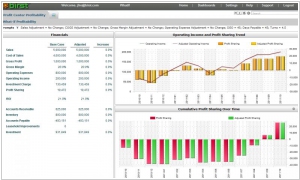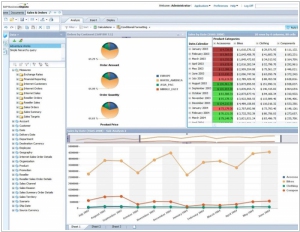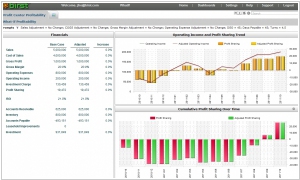Birst vs SAP Business Objects
May 25, 2023 | Author: Michael Stromann
8

Infor Birst is the only Enterprise BI platform born in the cloud. Find out why more than a thousand businesses rely on Birst for Enterprise BI. Learn to think fast. Enterprise-caliber BI delivers accurate, actionable content in an intuitive, self-service business intelligence environment. It allows users to combine data from different source systems in a single BI platform to get answers to their most pressing business concerns in real time. And, when the questions change, it adapts quickly to the new request.
7

Empower your people with easy access to the business intelligence (BI) and data visualization tools solutions they need to make faster, more informed decisions. Our BI platform and software can boost your organization’s collective IQ by giving all users the information necessary to drive smarter processes, improve performance, and become more effective in everything they do.
Birst and SAP Business Objects are both comprehensive business intelligence (BI) solutions, but they differ in various aspects:
1. Deployment Model: Birst is a cloud-native BI platform, designed to leverage the scalability and flexibility of cloud infrastructure. It offers a multi-tenant cloud environment and provides cloud-based analytics services. SAP Business Objects, on the other hand, offers both on-premises and cloud deployment options, giving organizations the flexibility to choose the deployment model that suits their needs.
2. Data Integration and ETL: SAP Business Objects provides robust data integration capabilities, allowing users to connect to various data sources and perform data transformations. It offers data integration and extract, transform, load (ETL) functionalities through its Data Services component. Birst also provides data integration features, but its focus is more on end-to-end data analytics, including data modeling, semantic layer creation, and governed data access.
3. Reporting and Visualization: SAP Business Objects is known for its strong reporting and visualization capabilities. It offers a wide range of pre-built reports, ad hoc reporting, and interactive visualizations. Birst also provides comprehensive reporting and visualization tools, including dashboards and visual exploration, but its strength lies in its ability to create governed, self-service analytics environments that empower business users.
4. Advanced Analytics: SAP Business Objects offers advanced analytics features such as predictive analytics, data mining, and statistical modeling through its SAP Predictive Analytics component. Birst, on the other hand, focuses more on providing a robust analytics platform for business users, with features like data blending, data modeling, and guided analytics.
5. Integration with SAP Ecosystem: SAP Business Objects seamlessly integrates with other SAP solutions, such as SAP ERP and SAP HANA, providing a comprehensive end-to-end analytics platform within the SAP ecosystem. Birst, while it offers integration capabilities with various data sources and systems, does not have the same level of native integration with SAP solutions.
6. Pricing and Licensing: Birst typically follows a subscription-based pricing model, offering different tiers based on the desired functionality and user count. SAP Business Objects offers various licensing options, including named user licenses and concurrent user licenses, with pricing based on the selected components and user types.
See also: Top 10 Business Intelligence software
1. Deployment Model: Birst is a cloud-native BI platform, designed to leverage the scalability and flexibility of cloud infrastructure. It offers a multi-tenant cloud environment and provides cloud-based analytics services. SAP Business Objects, on the other hand, offers both on-premises and cloud deployment options, giving organizations the flexibility to choose the deployment model that suits their needs.
2. Data Integration and ETL: SAP Business Objects provides robust data integration capabilities, allowing users to connect to various data sources and perform data transformations. It offers data integration and extract, transform, load (ETL) functionalities through its Data Services component. Birst also provides data integration features, but its focus is more on end-to-end data analytics, including data modeling, semantic layer creation, and governed data access.
3. Reporting and Visualization: SAP Business Objects is known for its strong reporting and visualization capabilities. It offers a wide range of pre-built reports, ad hoc reporting, and interactive visualizations. Birst also provides comprehensive reporting and visualization tools, including dashboards and visual exploration, but its strength lies in its ability to create governed, self-service analytics environments that empower business users.
4. Advanced Analytics: SAP Business Objects offers advanced analytics features such as predictive analytics, data mining, and statistical modeling through its SAP Predictive Analytics component. Birst, on the other hand, focuses more on providing a robust analytics platform for business users, with features like data blending, data modeling, and guided analytics.
5. Integration with SAP Ecosystem: SAP Business Objects seamlessly integrates with other SAP solutions, such as SAP ERP and SAP HANA, providing a comprehensive end-to-end analytics platform within the SAP ecosystem. Birst, while it offers integration capabilities with various data sources and systems, does not have the same level of native integration with SAP solutions.
6. Pricing and Licensing: Birst typically follows a subscription-based pricing model, offering different tiers based on the desired functionality and user count. SAP Business Objects offers various licensing options, including named user licenses and concurrent user licenses, with pricing based on the selected components and user types.
See also: Top 10 Business Intelligence software
Birst vs SAP Business Objects in our news:
2015. Cloud business intelligence service Birst raises $65M

Birst, a cloud-based business intelligence (BI) platform, has secured an additional $65 million in funding. The primary challenge Birst aims to address is the growing volume of electronic information being collected by businesses, which, when analyzed intelligently, has the potential to drive better strategic decision-making. While companies like IBM and others have been offering business intelligence solutions for some time, the issue lies in the prevalence of on-premise legacy systems that struggle to handle newer forms of data and lack the ability to leverage advanced algorithms for data extraction. Additionally, there is a growing demand for direct access to this information from business users themselves, bypassing the need for extensive involvement from a dedicated data analytics team. Birst's cloud-based BI platform seeks to bridge these gaps by providing a modern and agile solution that empowers businesses to effectively harness their data for informed decision-making.


